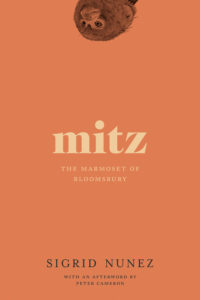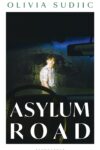
[Soft Skull Press; 2019]
Sigrid Nunez signals to readers of Mitz: The Marmoset of Bloomsbury very early on that she knows the kind of criticism the biography of Virginia and Leonard Woolf’s pet marmoset, the eponymous Mitz, might be likely to receive. Revisiting the days after Woolf finished her manuscript for Flush, the biography of Elizabeth Barrett Browning’s cocker spaniel, Nunez turns to the writer’s own diary, where Virginia “had already disparaged the book as ‘a joke,’ ‘a waste,’ ‘a bore,’ — ‘silly,’ ‘foolish,’ ‘witless,’ and ‘too long’ . . . ” and to contemporaneous reviews that echo the author’s self-critique. However, contrary to this catalog of detractions, a beloved pet serves as a singularly appropriate subject through which a story of change — epochal, mundane, or otherwise — can be told. The shape of the world in 1934, when the novel begins and Mitz first comes into the care of the Woolves, is drastically different than the shape of the world at its end, at the very close of 1938, the last year of peace for the United Kingdom. And Nunez, in telling the story of Bloomsbury’s unlikeliest, and certainly smallest, member, masterfully weaves that tale of change with warmth, gentleness, and compassion.
There is, of course, in this biography of a member of the Woolf household, also a biography of the Woolves themselves, as well as their friends and family and collaborators within the Bloomsbury circle. And thus Mitz’s story serves as a kind of lens for Virginia and Leonard’s story and for the story of a certain British milieu on the precipice of an outright restructuring of the world. War looms over the novel; Virginia’s nephew Julian returns from a post in China and decides to go serve in Spain, where he is killed after two months. It’s a death that in this retelling seems inevitable, as news of his death is met with the following observation: “Now one could say it: they had both known Julian would die in Spain.” Virginia tries to take consolation in the nobility of the cause for which her nephew died, but fails, a part of her resenting him for piercing the happiness that she and her sister Vanessa enjoyed in their otherwise cloistered world. It’s a strange sensation, seeing her cling so closely to the last vestiges of normalcy, given that an earlier trip through Europe showed the darkness of fascism swelling, steadily lapping at ever further shores. On that trip, Mitz serves as a distraction so exotic as to dissuade any prying questions about Leonard’s being Jewish and, though they are troubled by what they see in Germany, the Woolves manage to slip back into their routine as they make their way to Italy (where “fascism was ascendant . . . but there was nothing like the atmosphere of tension and menace that had been so thick in the land of the Nazis. The days were lazy, sun filled; the Italians as affable as ever.”). This ebb and flow of awareness of and obliviousness to the imminent evil is a central facet of the novel and is almost surprising: how could this monumental threat only occupy the occasional thought? But of course, we are almost never aware that history is happening around us until we see it in retrospect, in the past tense, after time has passed.
And Mitz acts as a perfect figure of indexicality of the passage of time. After all, she belongs to that curious category of family pet, a category marked with a strange and unique sense of time. There is something about inviting another animal into our homes, an animal whose lifespan is, on average, shorter than ours, that introduces an ever-present future tense reminder of impermanence and finitude. When we share our lives, our time, our spaces with our pets, we do so with the knowledge, albeit often tucked deep into the darkest recesses of our consciousness, that one of our future days will become, inevitably, one we remember as the day they died. Mitz, the marmoset of Bloomsbury, introduces naturally what all stories — the ones we write and read, the ones we tell others, the ones we tell ourselves — so desperately need; a beginning, and necessarily, an end. And thus does Mitz catalogue time for Virginia and Leonard, for their friends and family, and for the world itself. This indexicality is only amplified by the inclusion of a rich archive of materials, materials whose dates are retrievable, and which mark specific historical moments. Mitz herself acts as a reference point to which these archival materials can attach, a justification for their inclusion, a conduit for letters, diaries, and memoirs to enter an otherwise fictional narrative. As such, Mitz is in many ways a prism, a creature marked curiously by various temporalities and instrumentalized to document the lives of her caregivers and their friends. Her own interiority for nearly all of the novel, maintaining her mystery and inscrutability — Leonard and Virginia spend a good amount of time trying to decode her wants and needs — until the very end.
In what would turn out to be Mitz’s final night, the story finally slips into her perspective as she remembers the long journey that brought her from her home in South America to the English country estate where she is desperately fighting off a chill from the especially harsh winter weather. The memories recall other stories of captivity and torture and belie the horrific machinations of the same British empire about to feel the full force of World War II. If Mitz can be seen as a figure who marks the moment of suspension before the headlong free-fall into the disorder and chaos of that war, she also serves to remind readers that battles for power and dominion are omnipresent and are never victimless.
I am made uneasy, though, by the way this scene lends itself to a metaphorical reading that equates Mitz’s journey with the harrowing middle passages countless human beings were made to undertake as they were forced into slavery. Mitz surely does act to remind readers of the kinds of brutality Britain’s ruling class condoned and profited from throughout its history, but her suffering at the hands of colonial power does not — cannot, really — capture the human suffering inflicted by that colonial power.
But I think the scene highlights the central limitation of the animal-as-metaphor, insofar as it always allows space for a dangerous collapse of categories that, in addition to sometimes creating a more empathetic approach to living with and amongst nonhuman animals, also makes possible a dangerous dehumanization of humans themselves. It’s a dehumanization with a long history and a dangerous persistence, and one that Mitz, who, as the Woolves joke, once saved them from Hitler, perhaps ought not be caught up in.
And so what if we don’t read this scene metaphorically at all? What if, ultimately, the most striking thing about Nunez’s delicate, small novel dedicated to an equally delicate, small creature, is the care and intimacy and seriousness with which that creature is treated. The fictionalized Woolves demonstrate, simply in the way they seamlessly integrate Mitz, with all her whims and complications and autonomous ways of being, into their day-to-day existence, a fierce belief in the curious position companion animals occupy in our lives; another member of the family in everything but species, but notably not lacking in name and importance. And the novel in its broadest form is a testament to the possibility that nonhuman animals can, and perhaps ought to be considered similar in their subjecthood to their human companions; in crafting a biography for Mitz, Nunez suggests that she is just as deserving of a shared life story as the humans whose home she lives in. I’m reminded of something a professor in my graduate program used often in thinking about the project of literature; she offered that it might not be only to help teach us to be human, but to be humane as well. And Mitz, with all of its small moments of tenderness stacked against the amorphous and massive horror every turn of the page ushers closer, does a good bit of work to share that lesson.
Mary Pappalardo is a writer, editor, and teacher based in Ann Arbor. She has a PhD in English from Louisiana State University, and her writing has appeared in the Los Angeles Review of Books, Real Life, and others. She is an Assistant Fiction Editor at The Offing.
This post may contain affiliate links.







